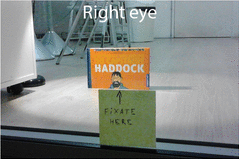Biology:Hering's law of visual direction

Hering's law of visual direction describes the perceived visual direction of a point relative to an observer, a perception which is influenced by the facial anatomy of human beings.
Description
Because the eyes are horizontally apart in the head, by about 6cm, the visual scene is seen from slightly different point of view by each eye. Thus comes the question of where a point is perceived, relative to the observer, when seen with either eye alone or binocularly. In 1879 Ewald Hering stated the following law: "For any given two corresponding lines of direction, or visual lines, there is in visual space a single visual direction upon which appears everything which actually lies in the pair of visual lines".[1] Prior to Hering, both Alhazen (1021) [2] and Wells (1792) [3] addressed a similar questions but proposed slightly incorrect laws.
Simplification
Hering's law can be simplified as (1) points falling on the same visual line seem to come from the same location; (2) visual directions are relative to the a unique egocenter (also called cyclopean eye) and (3) the perceived direction of a cyclopean line is the line that intersects the point of fixation. In other words, when seen monocularly a point appears in the direction of that point relative to the eye, but as if seen from the egocenter.
Demonstration
Hering proposed a simple demonstration of his law. When one fixates a point straight ahead on a window, one might see, through transparency, a different object in each eye aligned with the fixation point. For example in the right eye a house is seen behind the fixation point through the window. The house will appear to be located on the left. In the left eye a tree is seen behind the fixation through the window, appearing to be located on the right. When both eyes look at the fixation point, the house and the tree will appear superimposed in the cyclopean image, however the perceived location of these two superimposed images will be straight ahead. This demonstrates that the perceived location of a point is influenced by its location in both eyes and is relative to an imaginary cyclopean eye (or egocenter).

References
- ↑ Hering, Ewald (1942). Spatial sense and movements of the eyes. Baltimore: American Academy of Optometry. p. 42.
- ↑ Smith, A. Mark (2001). Alhacen's theory of visual perception. Volume Two, English Translation.. Philadelphia: American Philosophical Society.
- ↑ Wells, W. C. (1792). An Essay upon Single Vision with Two Eyes: Together with Experiments and Observations on Several Other Subjects in Optics. London: Cadell. https://archive.org/details/essayuponsinglev00well.
Further reading
- Howard, Ian P; Rogers, Brian J (2002). Seeing in Depth, vol. 2: Depth Perception. Ontario, Canada: I. Porteous.
- Ono, Hiroshi; Mapp, Alistair P (1995). "A restatement of Wells-Hering's law of visual direction". Perception 24 (2): 237–252. doi:10.1068/p240237. PMID 7617427.
See also
This article needs additional or more specific categories. (April 2023) |
 |

